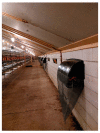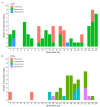Monitoring Wind-Borne Particle Matter Entering Poultry Farms via the Air-Inlet: Highly Pathogenic Avian Influenza Virus and Other Pathogens Risk
- PMID: 36558868
- PMCID: PMC9788232
- DOI: 10.3390/pathogens11121534
Monitoring Wind-Borne Particle Matter Entering Poultry Farms via the Air-Inlet: Highly Pathogenic Avian Influenza Virus and Other Pathogens Risk
Abstract
Wind-supported transport of particle matter (PM) contaminated with excreta from highly pathogenic avian influenza virus (HPAIv)-infected wild birds may be a HPAIv-introduction pathway, which may explain infections in indoor-housed poultry. The primary objective of our study was therefore to measure the nature and quantity of PM entering poultry houses via air-inlets. The air-inlets of two recently HPAIv-infected poultry farms (a broiler farm and a layer farm) were equipped with mosquito-net collection bags. PM was harvested every 5 days for 25 days. Video-camera monitoring registered wild bird visits. PM was tested for avian influenza viruses (AIV), Campylobacter and Salmonella with PCR. Insects, predominantly mosquitoes, were tested for AIV, West Nile, Usutu and Schmallenberg virus. A considerable number of mosquitoes and small PM amounts entered the air-inlets, mostly cobweb and plant material, but no wild bird feathers. Substantial variation in PM entering between air-inlets existed. In stormy periods, significantly larger PM amounts may enter wind-directed air-inlets. PM samples were AIV and Salmonella negative and insect samples were negative for all viruses and bacteria, but several broiler and layer farm PM samples tested Campylobacter positive. Regular wild (water) bird visits were observed near to the poultry houses. Air-borne PM and insects-potentially contaminated with HPAIv or other pathogens-can enter poultry air-inlets. Implementation of measures limiting this potential introduction route are recommended.
Keywords: Campylobacter; Salmonella; avian influenza virus; bird feathers; cobweb; faecal material; highly pathogenic avian influenza; insects; particle matter; plant; wild aquatic avian species.
Conflict of interest statement
The authors declare no conflict of interest.
Figures






Similar articles
-
Quantitative Risk Assessment of Wind-Supported Transmission of Highly Pathogenic Avian Influenza Virus to Dutch Poultry Farms via Fecal Particles from Infected Wild Birds in the Environment.Pathogens. 2024 Jul 8;13(7):571. doi: 10.3390/pathogens13070571. Pathogens. 2024. PMID: 39057798 Free PMC article.
-
Detection of airborne wild waterbird-derived DNA demonstrates potential for transmission of avian influenza virus via air inlets into poultry houses, the Netherlands, 2021 to 2022.Euro Surveill. 2024 Oct;29(40):2400350. doi: 10.2807/1560-7917.ES.2024.29.40.2400350. Euro Surveill. 2024. PMID: 39364599 Free PMC article.
-
Association of wild bird densities around poultry farms with the risk of highly pathogenic avian influenza virus subtype H5N8 outbreaks in the Netherlands, 2016.Transbound Emerg Dis. 2021 Jan;68(1):76-87. doi: 10.1111/tbed.13595. Epub 2020 May 18. Transbound Emerg Dis. 2021. PMID: 32419342 Free PMC article.
-
The genetics of highly pathogenic avian influenza viruses of subtype H5 in Germany, 2006-2020.Transbound Emerg Dis. 2021 May;68(3):1136-1150. doi: 10.1111/tbed.13843. Epub 2020 Sep 29. Transbound Emerg Dis. 2021. PMID: 32964686 Review.
-
The role of rodents in avian influenza outbreaks in poultry farms: a review.Vet Q. 2017 Dec;37(1):182-194. doi: 10.1080/01652176.2017.1325537. Vet Q. 2017. PMID: 28460593 Review.
Cited by
-
Campylobacter presence on Dutch broiler farms and associated risk factors.Poult Sci. 2024 May;103(5):103568. doi: 10.1016/j.psj.2024.103568. Epub 2024 Feb 19. Poult Sci. 2024. PMID: 38447312 Free PMC article.
-
Quantitative Risk Assessment of Wind-Supported Transmission of Highly Pathogenic Avian Influenza Virus to Dutch Poultry Farms via Fecal Particles from Infected Wild Birds in the Environment.Pathogens. 2024 Jul 8;13(7):571. doi: 10.3390/pathogens13070571. Pathogens. 2024. PMID: 39057798 Free PMC article.
-
Identifying an Understudied Interface: Preliminary Evaluation of the Use of Retention Ponds on Commercial Poultry Farms by Wild Waterfowl.Transbound Emerg Dis. 2024 Apr 3;2024:3022927. doi: 10.1155/2024/3022927. eCollection 2024. Transbound Emerg Dis. 2024. PMID: 40303142 Free PMC article.
-
The Role of Airborne Particles in the Epidemiology of Clade 2.3.4.4b H5N1 High Pathogenicity Avian Influenza Virus in Commercial Poultry Production Units.Viruses. 2023 Apr 19;15(4):1002. doi: 10.3390/v15041002. Viruses. 2023. PMID: 37112981 Free PMC article.
-
Effect of Periplaneta americana Residue Feed on Immunity, Antioxidant Capacity, and Transcriptome in Chickens: A Study on Sanhuang Chickens.Animals (Basel). 2025 Jan 3;15(1):94. doi: 10.3390/ani15010094. Animals (Basel). 2025. PMID: 39795037 Free PMC article.
References
-
- Swayne D.E., Suarez D.L., Sims L.D. Influenza. In: Swayne D.E., editor. Diseases of Poultry. 14th ed. John Wiley & Sons, Inc.; Hoboken, NJ, USA: 2020. pp. 210–256.
-
- Bouwstra R.J., Koch G., Heutink R., Harders F., van der Spek A., Elbers A.R.W., Bossers A. Phylogenetic analysis of highly pathogenic avian influenza A(H5N8) virus outbreak strains provides evidence for four separate introductions and one between-poultry farm transmission in the Netherlands, November 2014. Eurosurveillance. 2015;20:21174. doi: 10.2807/1560-7917.ES2015.20.26.21174. - DOI - PubMed
-
- Filaire F., Lebre L., Foret-Lucas C., Vergne T., Daniel P., Lelièvre A., de Barros A., Jbenyeni A., Bolon P., Paul M., et al. Highly Pathogenic Avian Influenza A(H5N8) Clade 2.3.4.4b Virus in Dust Samples from Poultry Farms, France, 2021. Emerg. Infect. Dis. 2022;28:1446–1450. doi: 10.3201/eid2807.212247. - DOI - PMC - PubMed
Grants and funding
LinkOut - more resources
Full Text Sources

